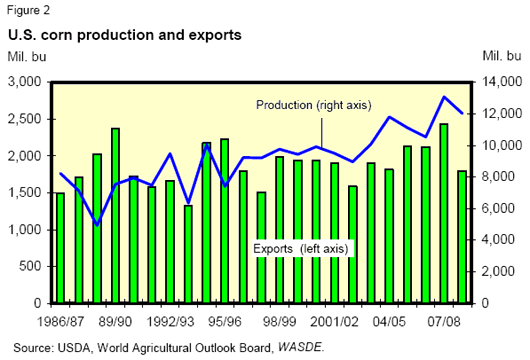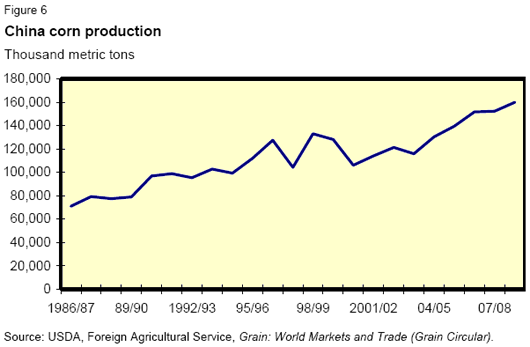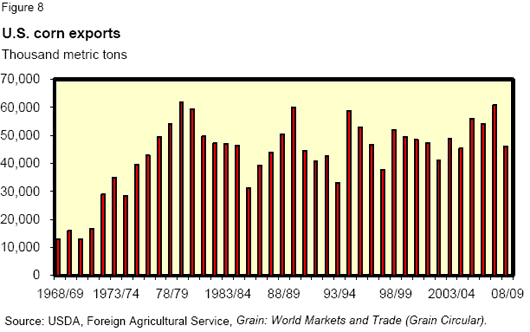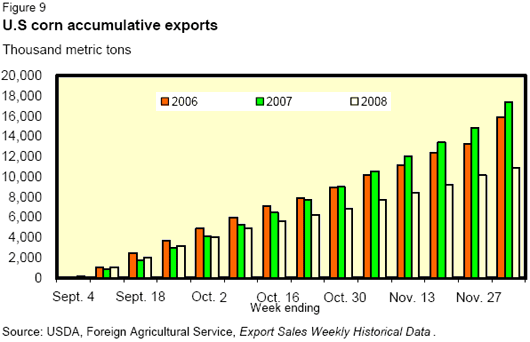



US Feed Outlook - December 2008
The current economic crisis in the US and around the world together financial problems within the ethanol idustry are continuing to hit demand for corn, according to the USDA Economic Research Service Feed Outlook report. Feed grain supplies for 2008/09 are up on November but slightly down year on year.Corn Use Lowered in 2008/09
The 2008/09 corn use forecast is lowered this month as financial and macroeconomic developments are continuing to weaken corn demand. Corn used to produce ethyl alcohol for fuel is lowered because of financial problems in the ethanol industry. Corn and sorghum exports are also lowered due to weak demand. Global 2008/09 coarse grain production is projected higher this month to a new record. World 2008/09 coarse grain ending stocks are now projected higher than beginning stocks. In previous months, forecasts showed global coarse grain stocks declining year-to-year. U.S. corn and sorghum farm prices are projected lower this month, oats prices are unchanged, and barley prices are raised because of high contracted malting barley prices.

Domestic Outlook
Feed Grain Exports Lowered This Month
Feed grain supplies for 2008/09 are forecast up slightly from November, with increased projections for barley and oat imports. Supplies are down, however, 18.7 million tons from 2007/08. The supply decrease reflects lower production year-to-year.
Total feed grain use is projected 9 million tons lower at 329.8 million this month. Domestic use of the four feed grains is lowered 6.1 million tons this month. This drop is the result of a decrease in expected corn used for ethanol, which also lowers the availability of distillers’ grains and increases corn and sorghum feed and residual use. Feed grain exports for 2008/09 are projected down 2.9 million tons this month. The decrease in domestic use and exports results in ending stocks being increased 9.1 million tons to 41.8 million. In 2007/08, ending stocks for the four feed grains totaled 45.1 million tons, so stocks are still expected to decline during 2008/09.
Feed and residual use for the four feed grains plus wheat converted to a September- August marketing year is up 1.4 million tons this month because of an increase in projected corn and sorghum feeding. Grain-consuming animal units are down due to lowered beef and poultry production forecasts in 2008 and 2009. Feed and residual use per animal unit increased slightly this month to 1.60 tons, compared with 1.57 tons last month and 1.72 tons in 2007/08. Lower prices and reduced distillers’ grains production projected this month support higher grain use per animal unit.
Domestic Corn Use Lowered in 2008/09
Food, seed, and industrial (FSI) use for 2008/09 is forecast down 300 million bushels to 5.0 billion this month. This decrease is caused by the decline in ethanol production, as prospects for blending above federally mandated levels diminish. Financial problems for ethanol producers are reducing plant capacity utilization for existing plants and delaying plant openings for those still under construction. Falling gasoline prices have also resulted in high relative prices for ethanol, reducing blender incentives and slowing production.


The 2008/09 season average farm price for corn is projected at $3.65-$4.35 per bushel, down on both ends of the range from last month’s $4.00-$4.80 per bushel.
Sorghum Export Prospects Lowered in 2008/09
Sorghum exports for 2008/09 are reduced to 130 million bushels, a decrease of 10 million from last month and down 148 million from last year. This drop is offset by higher forecast feed and residual use, up 10 million bushels to 250 million for 2008/09. There are no other changes made to sorghum supply and use this month.
The 2008/09 projected price range for sorghum is lowered to $3.00-$3.60 per bushel this month, compared with $3.40-$4.20 per bushel last month.


Barley and Oats Imports Increased
Barley imports for 2008/09 are forecast at 30 million bushels, up 5 million from last month. Exports are down 5 million bushels this month to 20 million, as high U.S. prices relative to those of other exporters limit export opportunities. There are no other changes in barley supply and use this month; as a result, barley ending stocks are increased 10 million bushels.
Oat imports are forecast up 5 million bushels to 110 million for 2008/09, due to the strong pace of imports from Canada. There are no changes made in use this month; therefore, oat ending stocks are increased 5 million bushels.
Prices received by farmers for barley are projected higher at $4.85-$5.45, compared with $4.70-$5.30 last month. This increase reflects high pre-planted contract prices for 2008 planted malting barley. Oat prices are projected at $2.80-$3.00 per bushel, narrowed 10 cents on both ends of the range from $2.70-$3.10 per bushel last month.
International Outlook
World Coarse Grain Production Boosted
Global 2008/09 coarse grain production is projected 5.7 million tons higher this month to a record 1,097.4 million. World corn production is increased 4.5 million tons to 785.9 million, mostly due to a larger crop in China. Global sorghum production is increased 0.5 million tons to 63.6 million, barley production is increased 0.4 million tons to 153.7 million, and millet production is increased 0.4 million tons to 35.6 million. World oat production is reduced 0.2 million tons to 26.2 million, while rye and mixed grain production were little changed. This month’s production changes were mostly driven by increased yields, raising the record average yield of world coarse grains to 3.50 tons per hectare for 2008/09.
China’s forecast 2008/09 corn production is up 4.0 million tons this month to 160.0 million, based on preliminary state reports of corn production, published estimates of total grain production, and the historical share of corn in various states. The corn harvest in China is virtually complete, but official national production data will not be published for months. Growing conditions were mostly favorable throughout China. Average corn yields are forecast at a record 5.48 tons per hectare, up 3 percent from the previous record in 2006/07.
EU-27 corn production is forecast up 1.4 million tons this month to 60.9 million. France, Italy, and Hungary reported larger than expected yields, boosting EU-27 average corn yields to a record 6.88 tons per hectare, slightly above the 2004/05 yield.
Corn production in Canada is up 0.7 million tons this month to 10.6 million tons, based on data from Statistics Canada. Corn harvested area was reduced slightly, but estimated yields were boosted to a record 9.1 tons per hectare, 5 percent above the 2005/06 yield.



Corn production in Ukraine is projected up 0.5 million tons this month to 10.0 million, based on harvest progress reports. Average yield is boosted to a record 4.55 tons per hectare, up 6 percent from the previous record in 2005/06. Above normal precipitation during critical growth stages and increased use of higher yielding imported corn seed contributed to strong yields.

There are small increases in 2008/09 corn production this month for Croatia, Burkina Faso, Nigeria, Senegal, Mali, Chad, and Mauritania.
Partly offsetting increases in corn production are reductions for Brazil, South Africa, and Benin. Brazil’s 2008/09 corn production prospects were cut 1.5 million tons this month to 53.5 million. Projected area is reduced this month as low corn prices and high production costs are expected to reduce second-crop dry-season plantings. Yield prospects are reduced slightly, reflecting early season dryness for main-crop corn in Parana. South Africa’s 2008/09 corn production prospects are reduced 1.0 million tons this month to 10.5 million due to lower planted area reported in government surveys. The low price of corn has reduced the incentive to plant, even though rainfall has been favorable, especially in the eastern parts of the maize triangle.
Canada’s 2008/09 barley production is up 0.6 million tons this month to 11.8 million due to increased area and yield reported by Statistics Canada. Canada’s average 2008/09 barley yield is a record 3.37 tons per hectare. Good rains and the absence of early frost in most areas boosted yields. The increase in Canada more than offset a small reduction in Brazil’s barley production based on smaller reported area.
Nigeria’s 2008/09 sorghum production increased 0.5 million tons this month to 11.0 million as favorable rains boosted average yields to a record 1.49 tons per hectare. Niger’s sorghum production is increased 0.2 million tons to 1.0 million due to good yields, but sorghum production in Burkina Faso declined 0.2 million tons to 1.6 million due to poor yields. There are small increases in sorghum production this month for Senegal and Mauritania.
Mali’s millet production is up 0.5 million tons this month, reaching 2.3 million tons due to record yields. There are smaller increases for Nigeria, Senegal and Chad, but small reductions for Niger, Burkina Faso,and Mauritania.
Oat production in Australia for 2008/09 is forecast down 0.2 million tons this month to 1.2 million as dryness has reduced yield prospects. Statistics Canada reported a slight decline in oat production as reduced area more than offset increased yields.
Increased Beginning Stocks Boost 2008/09 Coarse Grain Supplies
Global coarse grain beginning stocks estimated for 2008/09 are increased 1.6 million tons this month to 155.7 million. South Africa’s beginning stocks are increased 0.7 million tons to 3.3 million due to increased corn production reported for 2007/08. Mexico’s beginning stocks of coarse grain are increased 0.4 million tons due to the heavy pace of corn and sorghum imports during the final months of 2007/08. Chile’s 2008/09 beginning stocks are increased 0.2 million tons as corn consumption was revised back to 2005/06. Sorghum production for Australia in 2007/08 is revised up, boosting 2008/09 coarse grain beginning stocks 0.1 million tons. Increased corn imports for 2007/08 boosted Morocco’s 2008/09 beginning stocks 0.1 million tons. Numerous smaller changes to countries’ 2007/08 supply and demand also contribute to 2008/09 beginning stocks changes.
World Coarse Grain Consumption Drops on Lower U.S. Ethanol
World coarse grain consumption in 2008/09 is projected down 7.4 million tons to 1,087.6 million. Most of the drop is from lower corn use for ethanol in the United States, with foreign use down only 1.3 million tons to 806.9 million. This month’s drop in calculated foreign use reflects changes in the statistical trade imbalance as local marketing year exports are reduced more than local marketing year imports.
Forecasts for individual foreign country coarse grain use, in aggregate, are increased slightly this month. With increased production, projected consumption is boosted 0.7 million tons for Nigeria and 0.6 million for Mali. India’s corn consumption is boosted 0.5 million tons this month as prospects for exports are reduced and more corn is expected to be used for food in India. These and numerous smaller increases more than offset a decline of 0.7 million tons in projected corn use in Serbia, where feed use is now forecast to decline slightly yearto- year, and other small reductions are forecast in projected use.
Global Coarse Grains Stocks To Increase in 2008/09
World coarse grain stocks are projected up 14.6 million tons this month to 165.5 million tons. Ending stocks for 2008/09 are now projected nearly 10 million tons higher than beginning stocks, whereas previous months’ forecasts showed global coarse grain stocks declining year-to-year. U.S. stocks are still forecast to decline through 2008/09, but the foreign stocks buildup is more than offsetting. Foreign coarse grain stocks are projected up 5.5 million tons this month to 123.7 million.
Increased corn production is boosting China’s coarse grain ending stocks 4.0 million tons. The government is actively buying corn for reserves to support declining prices. Increased coarse grain production this month is boosting ending stocks prospects 1.5 million tons in the EU-27, 1.0 million in Canada, and 0.4 million in Ukraine. Increased beginning stocks are boosting ending stocks 0.4 million tons in Mexico. Reduced feed use prospects in Serbia are boosting projected ending stocks 0.4 million tons. These and numerous smaller increases to projected ending stocks more than offset declines projected in some countries this month.
Brazil’s 2008/09 ending corn stocks are projected 2.0 million tons lower this month as increased export prospects and reduced production are expected to trim burdensome stocks. Reduced production prospects in South Africa are also reducing stock prospects 0.3 million tons this month.
World Corn Trade Trimmed, U.S. Export Prospects Cut
Global corn trade in 2008/09 (October-September) is projected down 0.9 million tons this month to 80.7 million. This is down 16 percent from record world corn trade estimated for 2007/08.
Reduced prospects for feed consumption this month have trimmed forecast corn imports 0.3 million tons each for Chile and Vietnam, and 0.2 million tons for Syria.
Corn export prospects for 2008/09 increased 0.5 million tons this month for Brazil to a record 10.0 million. Large corn supplies in Brazil and a declining exchange rate are making Brazil’s corn prices very competitive. Serbia’s corn exports are forecast up 0.25 million tons this month to 1.0 million as internal feed demand weakens. Russia’s corn exports forecast for 2008/09 are doubled this month to 0.3 million tons due to the large crop and recent reported sales.
India’s corn export prospects are reduced 0.5 million tons this month to 1.0 million as internal prices are too high compared to world prices to encourage exports.
U.S. corn export prospects are reduced 1.5 million tons this month to 46.0 million. It is early in the marketing year, so there remains a great deal of uncertainty about the size of U.S. exports. The pace of sales and shipments to date has been very slow. With prices generally declining there is little incentive to buy forward. This is reflected in the level of outstanding sales, which at 8.8 million tons on December 4, 2008, is less than half the previous year’s record sales. Census corn exports of only 3.6 million tons in October and export inspections of only 3.2 million tons in November 2008 reflect the late U.S. corn harvest. U.S. export sales of corn are expected to increase when U.S. producers begin to market their corn more aggressively and competition with feed wheat from Europe becomes less intense.
U.S. 2008/09 sorghum exports are projected down 0.2 million tons this month to 3.3 million. The slow pace of sales and shipments to date is a factor, but competition from Australia’s increased 2007/08 crop is expected to limit U.S. sorghum exports to Japan. There were no other changes to projected 2008/09 sorghum trade this month.
U.S. barley export prospects were reduced slightly this month, while U.S. barley imports were increased slightly. High U.S. barley prices make exports less attractive and encourage imports.
Further Reading
| - | You can view the full report by clicking here. |
December 2008








